
The Highland Railway (HR) was one of the smaller British railways before the Railways Act 1921, operating north of Perth railway station in Scotland and serving the farthest north of Britain. Based in Inverness, the company was formed by merger in 1865, absorbing over 249 miles (401 km) of line. It continued to expand, reaching Wick and Thurso in the north and Kyle of Lochalsh in the west, eventually serving the counties of Caithness, Sutherland, Ross & Cromarty, Inverness, Perth, Nairn, Moray and Banff. Southward it connected with the Caledonian Railway at Stanley Junction, north of Perth, and eastward with the Great North of Scotland Railway at Boat of Garten, Elgin, Keith and Portessie.

The Great North of Scotland Railway (GNSR) was one of the two smallest of the five major Scottish railway companies prior to the 1923 Grouping, operating in the north-east of the country. Formed in 1845, it carried its first passengers the 39 miles (63 km) from Kittybrewster, in Aberdeen, to Huntly on 20 September 1854. By 1867 it owned 226+1⁄4 route miles (364.1 km) of line and operated over a further 61 miles (98 km).

The Keith and Dufftown Railway is a heritage railway in Scotland, running for 11 miles (18 km) from Keith Town, Keith to Dufftown via Drummuir and Auchindachy.

Elgin railway station is a railway station serving the town of Elgin, Moray in Scotland. The station is managed by ScotRail and is on the Aberdeen to Inverness Line.
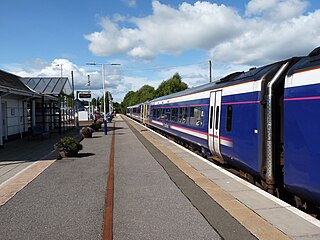
Keith railway station is a railway station serving the town of Keith, Moray, Scotland. The station is managed by ScotRail and is on the Aberdeen to Inverness Line. It is situated 3⁄4 mile (1.2 km) east of the town centre and is staffed on a part-time basis.

The Morayshire Railway was the first railway to be built north of Aberdeen, Scotland. It received royal assent in 1846 but construction was delayed until 1851 because of the adverse economic conditions existing in the United Kingdom. The railway was built in two phases with the section from Elgin to Lossiemouth completed in 1852. When the Inverness and Aberdeen Junction Railway (I&AJR) reached Keith via Elgin, the Morayshire was able to complete the Speyside second phase by connecting the Craigellachie line at Orton. Initially, the Morayshire ran its own locomotives on the I&AJR track between Elgin and Orton but this was short-lived and the Morayshire carriages were then hauled to Orton by the I&AJR. Disagreements with the I&AJR eventually forced the Morayshire into constructing a new section of track between its stations at Elgin and Rothes; this was completed in 1862. The Morayshire accomplished its final enlargement by connecting to the new Great North of Scotland Railway (GNoSR) Craigellachie station in 1863. Crippling debt forced the company into an arrangement with the GNoSR for it to assume operation of the track in 1866. By 1881, the Morayshire had greatly reduced its liabilities and its long-sought-after amalgamation with the GNoSR finally took place.
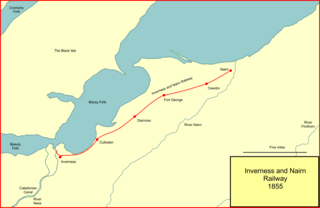
The Inverness and Nairn Railway was a railway company that operated between the burghs in the company name. It opened its line in 1855 and its passenger business was instantly successful. At first it was not connected to any other line. However it was seen as a first step towards connecting Inverness and Central Scotland, via Aberdeen and when feasible, directly southwards.
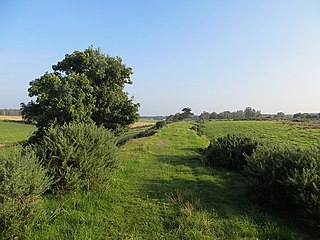
The Inverness and Perth Junction Railway (I&PJR) was a railway company that built a line providing a more direct route between Inverness and the south for passengers and goods. Up to the time of its opening, the only route was a circuitous way through Aberdeen. The I&PJR was built from a junction with the friendly Inverness and Aberdeen Junction Railway at Forres to the Perth and Dunkeld Railway at Dunkeld.
The Inverness and Aberdeen Junction Railway (I&AJR) was a railway company in Scotland, created to connect other railways and complete the route between Inverness and Aberdeen. The Inverness and Nairn Railway had opened to the public on 7 November 1855 and the Great North of Scotland Railway (GNoSR) was building from Aberdeen to Keith. The I&AJR opened, closing the gap, on 18 August 1856.
The Strathspey Railway was a railway company in Scotland that ran from Dufftown (in Moray to Boat of Garten (in Badenoch and Strathspey]], Scotland. It was proposed locally but supported by the larger Great North of Scotland Railway, which wanted to use it as an outlet towards Perth. The GNoSR had to provide much of the funding, and the value of traffic proved to be illusory. The line opened in 1863 to Abernethy, but for the time being was unable to make the desired connection to the southward main line. Although later some through goods traffic developed, the route never achieved its intended purpose.
The Buckie and Portessie Branch was a railway branch line in Scotland, built by the Highland Railway to serve an important fishing harbour at Buckie, in Banffshire. It connected with the rival Great North of Scotland Railway at Portessie.

Broomhill railway station or Broomhill for Nethy Bridge railway station is a reconstructed railway station on the former Highland Railway main line which was originally built to serve the small villages of Nethy Bridge and Dulnain Bridge in Strathspey. It is at present the eastern terminus of the Strathspey Steam Railway.
The Alford Valley Railway is a historic railway in Scotland that ran between Alford and Kintore. The company was formed in 1856, the line was opened in 1859, and it was absorbed by the Great North of Scotland Railway in 1866. It was closed to passengers in 1949 and to goods in 1965.
The Banff, Portsoy and Strathisla Railway was a Scottish railway company that connected the Aberdeenshire ports of Banff and Portsoy with the main line of the Great North of Scotland Railway (GNoSR) main line at Grange, a place some distance east of Keith. The railway opened in 1859, and was renamed the Banffshire Railway in 1863 when the GNoSR began running services.
Grange railway station was a railway station in the parish of Grange, historically in Banffshire. Opened in 1856 by the Great North of Scotland Railway, three years later it became a junction station after the Banff, Portsoy and Strathisla Railway built a branch to Banff and Portsoy.
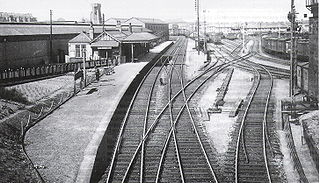
There have been three Kittybrewster railway stations at Kittybrewster, Aberdeen. The first opened in 1854 as a terminus of the Great North of Scotland Railway's (GNoSR) first line to Huntly. This was replaced two years later by a station on a new line to a city terminus at Waterloo. It was replaced again when the Denburn Valley Line to Aberdeen Joint opened in 1867.
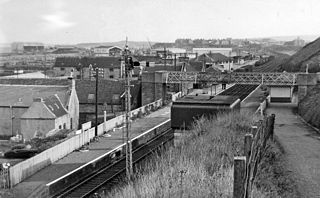
Buckie railway station was a railway station in Buckie, in current day Moray. The station was opened by the Great North of Scotland Railway (GNoSR) on its Moray Firth coast line in 1886, served by Aberdeen to Elgin trains.

Spey Bay railway station was a railway station in Spey Bay, Moray. The railway station was opened by the Great North of Scotland Railway (GNoSR) on its Moray Firth coast line in 1886, served by Aberdeen to Elgin trains. The station was originally named Fochabers-on-Spey railway station on 1 May 1886. In November 1893 it became Fochabers railway station, Fochabers and Spey Bay railway station on 1 January 1916 before finally becoming on 1 January 1918 Spey Bay railway station. It closed to regular passenger traffic on 6 May 1968 on the same date as the line itself.

Garmouth railway station was a railway station in Garmouth, parish of Urquhart, Moray. The railway station was opened by the Great North of Scotland Railway (GNoSR) on its Moray Firth coast line in 1884, served by Aberdeen to Elgin trains. It served the villages of Kingston-on-Spey and Garmouth and closed to regular passenger traffic on 6 May 1968 on the same date as the line itself.













